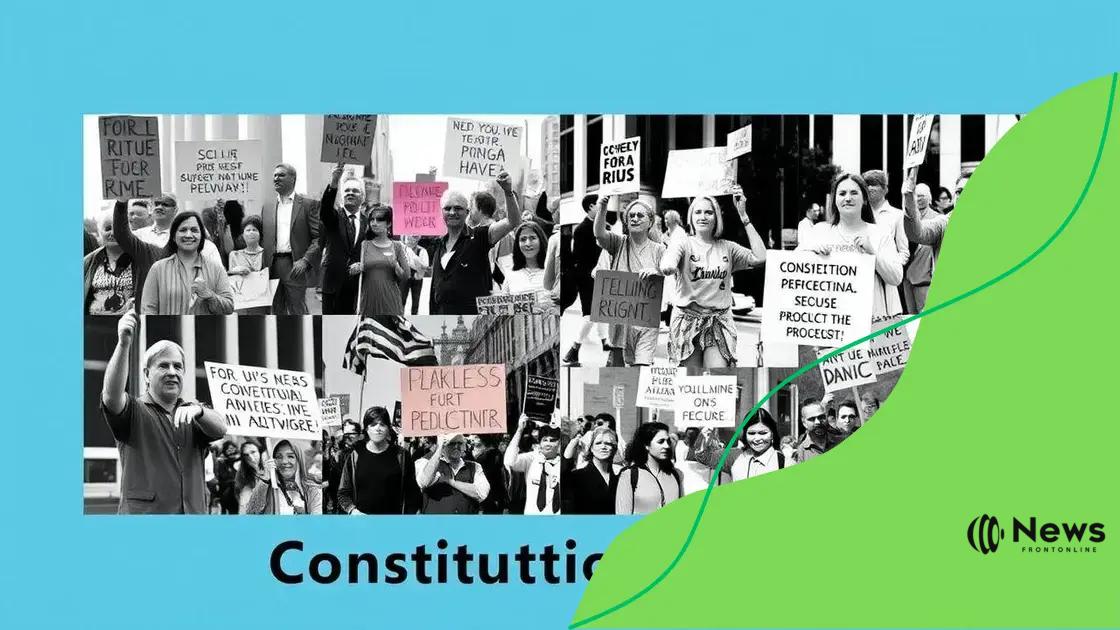Constitutional rights demonstrations and their impact
Constitutional rights demonstrations are crucial for advocating freedoms and bringing attention to social issues, leveraging social media and legal know-how to mobilize support and influence change.
Constitutional rights demonstrations are crucial in advocating for justice and equality. Have you ever wondered how these movements influence societal changes?
Understanding constitutional rights
When we speak about understanding constitutional rights, it is vital to recognize their significance in ensuring freedom and equality for all. These rights serve as the foundation of a democratic society, protecting individuals from potential government overreach.
Constitutional rights encompass various protections, including freedom of speech, religion, and assembly. These rights are designed to safeguard our daily lives and are often at the heart of public demonstrations.
Key Aspects of Constitutional Rights
One important aspect of constitutional rights is their enforceability. Individuals have the right to challenge laws or actions that they feel infringe upon their rights. This ability empowers citizens and promotes accountability within government entities.
The Role in Democracy
Another critical role of constitutional rights is their contribution to a vibrant democracy. Without such protections, individuals would struggle to voice their opinions freely. Democracy thrives when people can express their thoughts openly and organize for a common cause.
- Preserves individual freedoms
- Allows for peaceful protests
- Encourages civic engagement
Overall, understanding constitutional rights lays the groundwork for participating in societal discussions and advocating for change. Awareness of these rights can lead to greater involvement in community issues and national debates.
Whether one is learning about these rights in a classroom or encountering them in real life, it is essential to grasp their importance in shaping our society. Knowledge empowers individuals to stand up for their rights and those of others, fostering a sense of unity and shared responsibility.
Historical context of demonstrations
The historical context of demonstrations is essential for understanding how they shape our society. Throughout history, various movements have emerged to defend constitutional rights and push for social change. Each demonstration reflects the values and struggles of its time.
For instance, the civil rights movement of the 1960s was a pivotal moment in American history. Activists sought to end racial segregation and ensure that all individuals enjoyed equal rights under the law. Their efforts, often through peaceful protests, highlighted the importance of civic engagement.
Significant Historical Demonstrations
Several demonstrations have left a lasting impact and are remembered today. Some of these include:
- The March on Washington for Jobs and Freedom (1963)
- Stonewall Riots (1969)
- The Women’s March on Washington (2017)
These events not only raised awareness about specific issues but also united people from various backgrounds. They showed that collective action can influence legislation and public opinion.
Demonstrations often arise in response to injustice, reflecting the societal desire for change. By understanding this historical context, we can appreciate the courage of those who protested for what they believed in. Their actions pave the way for future generations to advocate for their rights.
Notably, historical demonstrations have evolved with technology. Social media now plays a significant role in organizing movements and disseminating information. Online platforms enable a broader audience to participate and support causes they care about.
Key moments in constitutional rights activism

Key moments in constitutional rights activism have shaped the landscape of civil rights in numerous ways. These pivotal events often send powerful messages about justice, equality, and the need for societal change.
One of the most significant moments occurred during the Civil Rights Movement in the 1960s. Activists organized marches, sit-ins, and boycotts to challenge segregation and discrimination. Their efforts led to crucial legislation, including the Civil Rights Act of 1964.
Important Events in Activism
Several key moments stand out in the history of constitutional rights activism:
- The Montgomery Bus Boycott (1955-1956)
- The Selma to Montgomery March (1965)
- The Stonewall Riots (1969)
Each of these events played an important role in advancing the cause of civil liberties. They mobilized massive public support and brought national attention to issues of injustice.
Additionally, the Women’s Rights Movement saw significant milestones, such as the passage of the Equal Pay Act in 1963 and the Women’s March on Washington in 2017. These events illustrated the ongoing struggle for gender equality, as activists fought for their constitutional rights.
In recent years, the rise of technology has allowed movements to grow rapidly. Social media campaigns, like Black Lives Matter, have sparked global conversations about racial injustice and police brutality. This modern form of activism continues to influence public opinion and policy today.
The resilience of activists throughout history highlights their dedication to ensuring that constitutional rights are upheld. By reflecting on these key moments, we can better understand the ongoing fight for justice.
The role of social media in modern demonstrations
The role of social media in modern demonstrations cannot be overstated. Social media platforms have transformed how activists organize and share information, making it easier to mobilize people for a cause.
Today, individuals can use platforms like Twitter, Facebook, and Instagram to raise awareness about issues and coordinate events. For instance, hashtags such as #BlackLivesMatter have helped galvanize support and spread messages rapidly across diverse audiences.
Key Benefits of Social Media in Activism
Social media provides several advantages that empower modern demonstrations:
- Instant communication allows for real-time updates.
- Global reach enables campaigns to connect with larger audiences.
- Visual storytelling through images and videos amplifies messages.
- Community building fosters solidarity among activists.
Additionally, social media acts as a platform for marginalized voices. Those who may not have traditional outlets can share their stories and perspectives. This sharing creates a richer dialogue around social issues, leading to increased understanding and empathy.
Furthermore, during demonstrations, social media can help document events as they unfold. Participants can live-stream protests and share their experiences, ensuring that these moments are recorded and that voices are heard. This documentation often invites media coverage and can lead to broader public support.
However, while social media serves as a powerful tool, it also faces challenges. Misinformation can spread quickly, complicating narratives around demonstrations. Activists must remain vigilant in sharing accurate information to counter false narratives and stay focused on their goals.
Legal implications of constitutional gatherings
The legal implications of constitutional gatherings are crucial to understand, as they define what rights individuals have when coming together to express their beliefs. These gatherings, such as protests and demonstrations, are protected under the First Amendment of the U.S. Constitution, which guarantees the right to assemble peacefully.
However, there are laws and regulations governing these assemblies. Understanding these can help protect individuals and ensure that events proceed smoothly. For example, organizers often need to obtain permits for large gatherings in public spaces. This process ensures public safety and allows local authorities to manage traffic and crowd control effectively.
Key Legal Considerations
Several legal aspects are important to consider regarding constitutional gatherings:
- Permitting and Regulations: Many cities require permits for protests or large assemblies. Failure to obtain these can result in fines or dispersal of the gathering.
- Time, Place, and Manner Restrictions: Authorities can impose certain restrictions on when and where protests occur, as long as these rules are applied equally to all groups.
- Free Speech Protections: While speech is protected, it must not incite violence or pose a direct threat to public safety. Understanding these boundaries is key for activists.
- Law Enforcement Interaction: Knowing how to interact with law enforcement can help mitigate risks during demonstrations. It’s important for protestors to understand their rights and when to assert them.
Legal education around gatherings is essential. Activists should know their rights and responsibilities to minimize risks during demonstrations. Resources such as legal aid organizations offer support and guidance on navigating these issues.
Moreover, the rise of digital platforms has introduced new challenges. Online organization of gatherings can sometimes lead to unexpected legal implications, especially if misinformation circulates about the event. Being aware of these complexities is vital for modern activism.
FAQ – Frequently Asked Questions about Constitutional Rights and Demonstrations
What are constitutional rights?
Constitutional rights are legal protections guaranteed by a constitution, ensuring freedoms such as speech, assembly, and religion.
How does social media influence demonstrations?
Social media allows for rapid communication, mobilizes support, and raises awareness about causes, making it a powerful tool for activists.
What legal considerations should activists keep in mind?
Activists should understand permit requirements, time and manner restrictions, and their rights to ensure peaceful and lawful demonstrations.
Why are historical moments in activism important?
Historical moments highlight the struggles and successes of past activists, providing inspiration and context for current movements.





